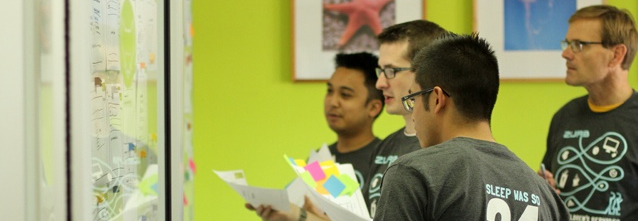When we helped nonprofits in the past, we learned quickly that an inspiring mission wasn't enough to help an organization, especially if it was disorganized and didn't operate efficiently. We found that marketing opportunities got stuck too easily, stalling the ability of the organization to drive a mission forward. Or that problems were closed down rather than being opened up.
Nonprofits, and a fair share of businesses too, are programed that they shouldn't take action until they've thought every last detail through, plotting out the best answer rather than exploring multiple options. The danger of this type of mentality is burnout. You spend so much energy thinking about getting things 100% right that there's very little left to actually do something. Nothing gets done and nonprofits grind to a halt. Whereas design thinking can allow you to get things done, get them done faster and on time without getting caught up in every tiny detail.
Or as Tim Brown and Jocelyn Wyatt, of IDEO, put it:
The design thinking process is best thought of as a system of overlapping spaces rather than a sequence of orderly steps. There are three spaces to keep in mind: inspiration, ideation and implementation. Think of inspiration as the problem or opportunity that motivates the search for solutions; ideation as the process of generating, developing, and testing ideas; and implementation as the path that leads from the project stage into people's lives.
Nonprofits Benefit from Design Thinking
The folks at IDEO have seen firsthand how nonprofits benefit from design thinking. In fact, IDEO used design thinking when they helped VisionSpring, a nonprofit that provides eye care to third-world countries, come up with a program for children in India.
In 2009, IDEO designers used prototyping, a crucial step in implementation, to see what would get the children excited about getting their eyes examined. Traditional eye exams resulted in lots of tears. So they did another iteration of the process, this time letting the children exam their teacher's eyes, which got the kids excited. Finally, after another iteration of the process, they had the children exam one another and talk about the process.
Design thinking, especially prototyping, helped refine and create a viable children's eye care program for VisionSpring. As a result, they conducted 10 eye camps across India, screening 3,000 and putting glasses on the faces of 69 kids. VisionSpring has now integrated design thinking into their company's processes, using prototypes to gather feedback before they implement a new program.
Imagine for a second if VisionSpring hadn't relied on IDEO and design thinking. VisionSpring may have gotten stuck trying to figure out on paper how to change the traditional eye exam, making assumptions without really getting an idea on how they would really work out in the wild until it was too late.
ZURBwired Helps Nonprofits Learn Design Thinking
At ZURB, we very much believe in being coaches, teaching others our best practices and how best to approach problems through design thinking. Which is one of the reasons we started ZURBwired, our 24-hour event that helps one nonprofit get over a design hump.
 ZURBians using design thinking to solve problems at last year's ZURBwired.
ZURBians using design thinking to solve problems at last year's ZURBwired.Not only do we work hard at solving a design problem for the nonprofit, but in the process we teach them how to implement design thinking and our methods to their daily processes. In 24 hours, we go through every step in the design process from ideation to prototype to implementation. In the end, not only does the nonprofit get to meet their marketing goals, but they learn how to do it again for themselves.
It's Not Too Late To Submit Proposals
This year will be our fifth ZURBwired. And it's not too late to get your submission in. We've extended our submissions deadline to this Friday, July 6, to give nonprofits some extra time to get their proposals in.
Submit Your Nonprofit's Proposal